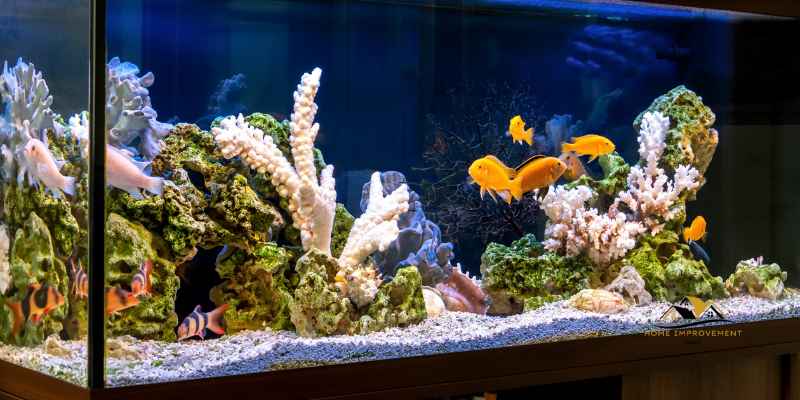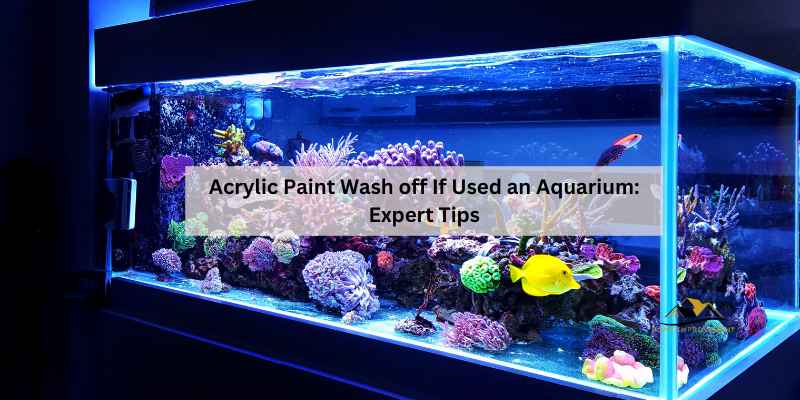Acrylic paint can be washed off an aquarium if it is water-based, non-toxic, and designed for aquarium use. Ensure it dries completely before adding water.
When considering using acrylic paint in an aquarium, it’s crucial to understand its compatibility and safety for aquatic life. Acrylic paint can serve as a versatile and colorful option for enhancing the aesthetics of an aquarium. However, it is essential to choose a water-based and non-toxic acrylic paint specifically formulated for aquarium applications to prevent any harm to the aquatic environment.
Additionally, allowing the paint to dry thoroughly before introducing water can ensure its longevity and prevent any adverse effects on the aquatic ecosystem. Understanding the proper usage and removal techniques of acrylic paint in aquariums can contribute to a visually pleasing and safe underwater environment for aquatic inhabitants.
Safety Considerations
When using acrylic paint in an aquarium, it is important to consider the safety implications to ensure the well-being of the aquatic environment. Understanding the safety considerations of using acrylic paint in an aquarium is crucial to prevent harm to the aquatic life and maintain a healthy ecosystem. Below, we will delve into some essential safety considerations when using acrylic paint in an aquarium.
Water-based And Non-toxic Paints
When painting the interior or exterior of an aquarium, it is imperative to use water-based and non-toxic paints. These types of paints are formulated to be safe for aquatic life and will not leach harmful chemicals into the water. Using water-based and non-toxic paints helps to maintain a healthy aquatic environment and ensures the well-being of the fish and plants within the aquarium.
Designated Aquarium Use
It is essential to use acrylic paint that is specifically designated for aquarium use. These paints are designed to be safe for aquatic environments and have been tested to ensure they do not pose any harm to the inhabitants of the aquarium. Using designated aquarium paint provides peace of mind and reassurance that the paint will not negatively impact the aquatic ecosystem.
Application Process
When using acrylic paint in an aquarium, proper application is crucial to ensure the safety of your aquatic pets. Follow these guidelines for a successful application process.
Guidelines For Applying Acrylic Paint
- Choose water-based, non-toxic acrylic paint designed for aquarium use.
- Thoroughly clean and dry the aquarium surface before painting.
- Apply the acrylic paint in thin, even layers to prevent buildup.
- Use a soft brush or sponge for smooth application.
Drying Period Before Filling
- Allow the acrylic paint to dry completely as per the manufacturer’s instructions.
- Avoid rushing the drying process to prevent paint leaching into the water.
- Ensure proper ventilation to speed up the drying period.
Remember, patience is key when it comes to applying acrylic paint in an aquarium. By following these guidelines and allowing sufficient drying time, you can enjoy a beautifully painted aquarium without compromising the safety of your aquatic pets.
Removing Acrylic Paint

Cleaning Wet Acrylic Paint
When dealing with wet acrylic paint in an aquarium, the process of removal is relatively straightforward. Simply use a damp cloth or sponge to gently wipe off the paint from the surface. Ensure to act quickly to prevent the paint from drying and adhering to the aquarium.
Challenges Of Dried Acrylic Paint
Once acrylic paint has dried in an aquarium, removing it becomes a more challenging task. The paint forms a strong bond with the surface, making it resistant to simple water-based cleaning methods. Special care and techniques are required to effectively eliminate dried acrylic paint from the aquarium.
Environmental Impact
Acrylic paint, if used in an aquarium, can have a significant environmental impact. It is important to consider the proper disposal of acrylic paint waste water and to take measures to prevent contamination of waterways.
Disposal Of Acrylic Paint Waste Water
Disposing of acrylic paint waste water requires careful consideration. Acrylic paint contains various chemicals and pigments that can be harmful to the environment if not handled properly. When cleaning acrylic paint from an aquarium, it is crucial to avoid pouring the waste water directly down the sink or into the sewage system. Instead, proper treatment and disposal methods should be followed to prevent environmental harm.
Preventing Contamination Of Waterways
Preventing the contamination of waterways is essential when dealing with acrylic paint waste water. This can be achieved by using appropriate filtration methods to remove paint particles and chemicals from the waste water before disposal. Additionally, implementing measures to ensure that the treated waste water does not seep into natural water bodies is crucial to safeguarding the environment.
Expert Advice
Expert Tips For Refinishing Acrylic Aquariums
Refinishing an acrylic aquarium requires careful consideration and precise execution to maintain the integrity of the tank. Here are some expert tips to ensure a successful refinishing process:
- Thoroughly clean the aquarium surface before refinishing to remove any dirt, grime, or previous paint residue.
- Use a fine-grit sandpaper to gently sand the surface, creating a smooth and even texture for the new paint to adhere to.
- Apply the new paint in thin, even coats to prevent drips and ensure proper coverage.
- Allow each coat of paint to dry completely before applying the next layer.
- Consider using a specialized aquarium-safe paint to ensure the health and safety of your aquatic inhabitants.
- Regularly inspect the refinished surface for any signs of wear or damage, and promptly address any issues to maintain the tank’s aesthetic appeal and functionality.
Recommended Alternatives To Acrylic Paint
When it comes to refinishing or decorating an aquarium, there are several alternatives to acrylic paint that can achieve similar or even superior results:
- Plastic Adhesive Films: These self-adhesive films come in a variety of colors and patterns, providing a quick and easy way to enhance the appearance of your aquarium without the need for paint.
- Aquarium-safe Decals: Decorative decals designed specifically for aquarium use can add visual interest to the tank without the potential risks associated with traditional paint.
- Colored Acrylic Sheets: Opt for pre-colored acrylic sheets that can be cut to size and easily installed to create a customized and vibrant backdrop for your aquarium.
- LED Lighting Effects: Explore the use of colorful LED lighting to create stunning visual effects within the aquarium, eliminating the need for paint altogether.
- Non-toxic Water-based Markers: Utilize aquarium-safe markers to add artistic touches to the tank without the permanence of paint, allowing for easy modification and experimentation.
Community Insights
Using acrylic paint in an aquarium may lead to issues with washing it off. It’s important to ensure the paint is water-based, non-toxic, and designed for aquarium use. Once applied, allow it to completely dry before filling the aquarium with water to avoid any potential problems with the paint.
Experiences With Acrylic Paint In Aquariums
Users have shared their experiences using acrylic paint in aquariums. When properly applied, acrylic paint can be a safe and vibrant option for decorating aquariums.
Community Recommendations
Community members recommend using water-based, non-toxic acrylic paint designed specifically for aquarium use. Ensure thorough drying before introducing water to the aquarium to prevent any harmful effects on aquatic life.
Frequently Asked Questions
Is Acrylic Paint Ok In An Aquarium?
Yes, you can use acrylic paint in an aquarium as long as it is water-based, non-toxic, and designed for aquarium use. Make sure to follow the application guidelines and allow it to dry completely before filling the tank with water.
Acrylic paint is water-resistant and cannot be removed with water once it has dried.
Does Acrylic Paint Wash Off With Water?
Yes, acrylic paint washes off with water when wet. Once dried, it becomes water-resistant and cannot be removed easily.
Can Dried Acrylic Paint Be Washed Off?
Once dried, acrylic paint is challenging to wash off surfaces; scraping with soap and water may help.
Does Acrylic Paint Contaminate Water?
Yes, acrylic paint can contaminate water if not disposed of properly. It should never be poured down the sink or rinsed off palettes in running water. Acrylic paint hardens when it dries and can block drains, cause damage, pollute waterways, and harm wildlife.
It is important to follow proper disposal methods.
Conclusion
It is possible for acrylic paint to wash off if used in an aquarium, but it depends on the type of paint used and the application process. Water-based, non-toxic, and aquarium-specific acrylic paints are safe to use, but it is important to let the paint dry completely before filling the aquarium with water.
If the paint has already dried, it can be challenging to remove, and scraping it off might be the best option. Overall, it is essential to follow proper disposal methods for acrylic paint waste to avoid polluting our waterways.


